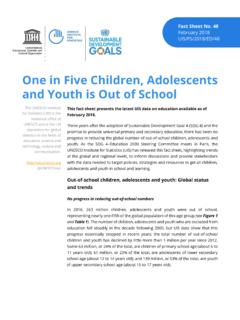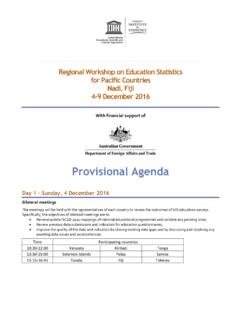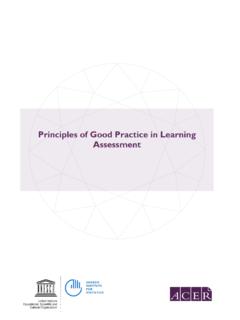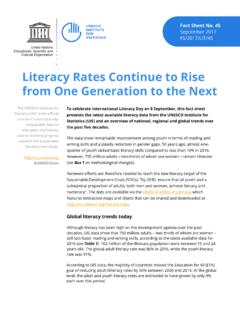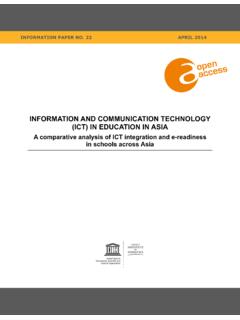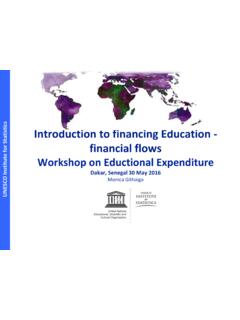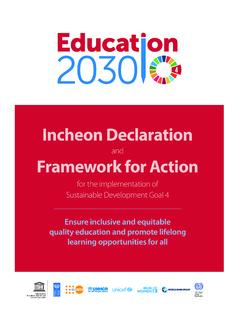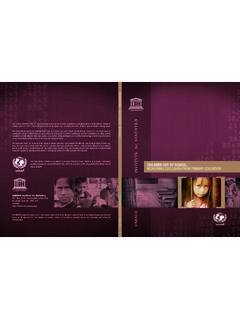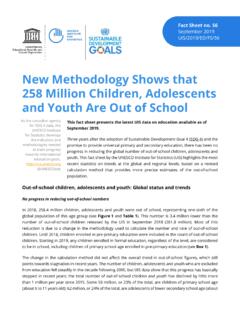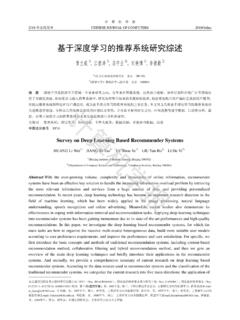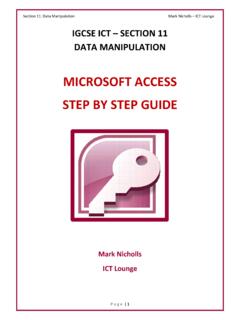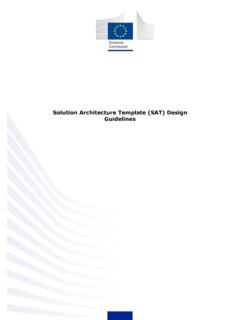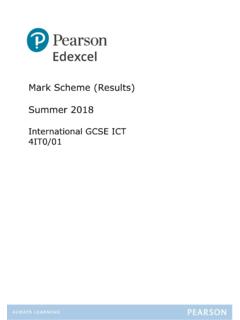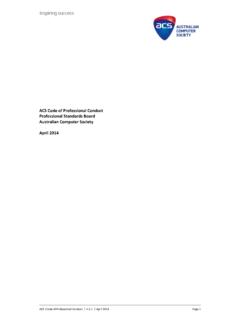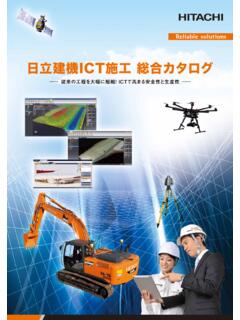Transcription of INFORMATION AND COMMUNICATION TECHNOLOGY (ICT) …
1 INFORMATION PAPER NO. 25 AUGUST 2015 INFORMATION AND COMMUNICATION TECHNOLOGY (ICT) IN education IN SUB-SAHARAN AFRICA A comparative analysis of basic e-readiness in schools UNESCO The constitution of the United Nations Educational, Scientific and Cultural Organization (UNESCO) was adopted by 20 countries at the London Conference in November 1945 and entered into effect on 4 November 1946. The Organization currently has 195 Member States and 9 Associate Members. The main objective of UNESCO is to contribute to peace and security in the world by promoting collaboration among nations through education , science, culture and COMMUNICATION in order to foster universal respect for justice, the rule of law, and the human rights and fundamental freedoms that are affirmed for the peoples of the world, without distinction of race, sex, language or religion, by the Charter of the United Nations.
2 To fulfil its mandate, UNESCO performs five principal functions: 1) prospective studies on education , science, culture and COMMUNICATION for tomorrow's world; 2) the advancement, transfer and sharing of knowledge through research, training and teaching activities; 3) standard-setting actions for the preparation and adoption of internal instruments and statutory recommendations; 4) expertise through technical co-operation to Member States for their development policies and projects; and 5) the exchange of specialized INFORMATION . UNESCO is headquartered in Paris, France. UNESCO Institute for Statistics The UNESCO Institute for Statistics (UIS) is the statistical office of UNESCO and is the UN depository for global statistics in the fields of education , science and TECHNOLOGY , culture and COMMUNICATION .
3 The UIS was established in 1999. It was created to improve UNESCO's statistical programme and to develop and deliver the timely, accurate and policy-relevant statistics needed in today s increasingly complex and rapidly changing social, political and economic environments. The UIS is based in Montreal, Canada. This report was prepared by Peter Wallet of the UNESCO Institute for Statistics, assisted by Beatriz Valdez Melgar for the production of graphs and statistical tables. Published in 2015 by: UNESCO Institute for Statistics Box 6128, Succursale Centre-Ville Montreal, Quebec H3C 3J7 Canada Tel: (1 514) 343-6880 Email: UNESCO-UIS 2015 ISBN 978-92-9189-178-8 Ref: UIS/2015/ICT/TD/5 DOI This publication is available in Open Access under the Attribution-ShareAlike IGO (CC-BY-SA IGO) license ( ).
4 By using the content of this publication, the users accept to be bound by the terms of use of the UNESCO Open Access Repository ( ). The designations employed and the presentation of material throughout this publication do not imply the expression of any opinion whatsoever on the part of UNESCO concerning the legal status of any country, territory, city or area or of its authorities or concerning the delimitation of its frontiers or boundaries. The ideas and opinions expressed in this publication are those of the authors; they are not necessarily those of UNESCO and do not commit the Organization. - iii - Table of contents Page Acknowledgements .. iv Introduction.
5 5 1. Why do we measure ICT in education ? .. 5 2. Methodology: E-readiness as a framework for quantifying ICT in education .. 6 3. Challenges measuring ICT in education in sub-Saharan Africa .. 8 4. Integrating ICT in education through policy, formal commitments and curriculum .. 8 5. Electricity in schools .. 11 6. Computer density .. 14 7. Computer-assisted instruction and deployment .. 15 8. Internet to support online learning .. 18 9. Looking forward: A call for action .. 20 References .. 21 Reader s Annex. Statistical tables ..25 List of boxes Box 1. WSIS targets on education and related indicators .. 6 Box 2. Various ICTs in primary schools in sub-Saharan African: Evidence from the Southern and Eastern Africa Consortium for Monitoring Educational Quality (SACMEQ), 2007.
6 7 Box 3. Supporting learning in schools and communities through broadcast community radio: Two examples of radio-assisted instruction in Uganda and Liberia .. 13 Box 4. Solar-powered mobile ICT computer labs: An innovative solution to connect rural sub-Saharan African schools .. 16 Box 5. Using mobile phones to improve literacy skills in home-based programmes with primary children in disadvantaged districts of Uganda .. 19 List of figures Figure 1. Proportion of Grade 6 pupils in primary schools with radio, television and computer(s), by country, 2007 .. 7 Figure 2. education levels including an objective or course in basic computer skills or computing, 2013.
7 10 Figure 3. Electricity in public educational institutions, primary and secondary, 2013 .. 12 Figure 4. Pupil (learner)-to-computer ratio, primary and secondary, 2013 .. 15 Figure 5. Computer-assisted instruction and laboratories, primary and secondary, 2013 .. 17 Figure 6. Proportion of educational institutions with Internet, primary and secondary, 2013 .. 18 Figure 7. Zero scores by literacy subtest at baseline and endline for all groups .. 19 List of tables Table 1. Countries in sub-Saharan Africa and policy on ICT in education , 2014 .. 9 Table 2. education level for the introduction of formal recommendations to integrate ICT in all curricular subjects, 2014.
8 11 - iv - Acknowledgements Data presented in this report are the result of a co-sponsored data collection by the UNESCO Institute for Statistics (UIS), the Korea education and Research INFORMATION Service (KERIS), and the Brazilian Regional Center for Studies on the Development of the INFORMATION Society ( ). Two capacity building workshops on ICT in education statistics were held in Dakar, Senegal from 7 to 9 September 2013 and in Harare, Zimbabwe from 22 to 24 September 2014. From KERIS the UIS would like to thank Mr Byeong-gil SOHN, Director of Global Policy Research Center, Ms Bosun KIM, Chief of Global Cooperation Section, and Mr Jongwon SEO, Senior Researcher.
9 The UIS would also like to thank from Mr Alexandre Fernandes Barbosa, General Manager and Ms Camila Garroux, INFORMATION Analyst. - 5 - Introduction INFORMATION and COMMUNICATION TECHNOLOGY (ICT) plays an ever important role in increasing economic productivity through digital economies, enhancing the delivery of public and private services and achieving broad socio-economic goals in education , health care, employment and social development. As a result, countries are advancing ICT policies to underpin growth in a variety of socio-economic sectors and help steer development and competition. Yet given the rapidly evolving ICT landscape due to a variety of newly emerging technologies, systematic examination and evaluation of these policies are essential.
10 In the education sector, policymakers widely accept that access to ICT can help individuals to compete in a global economy by creating a skilled work force and facilitating social mobility. They emphasise that ICT in education has a multiplier effect throughout the education system, by: enhancing learning and providing students with new sets of skills; reaching students with poor or no access (especially those in rural and remote regions); facilitating and improving the training of teachers; and minimising costs associated with the delivery of traditional instruction. Beyond the rhetoric and of great importance to policymakers are basic questions related to the usage of ICT in education and student outcomes, including retention and learning achievement.
